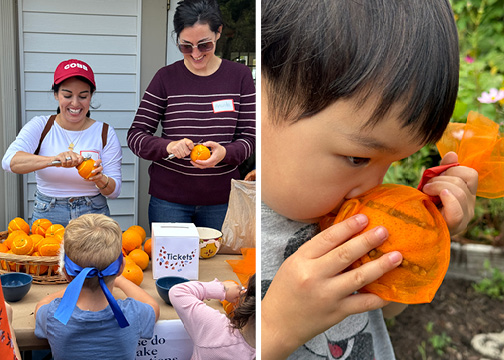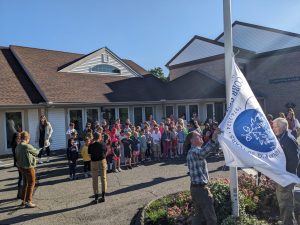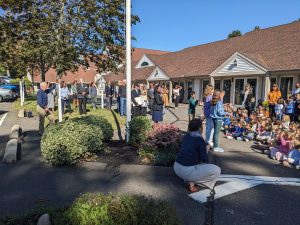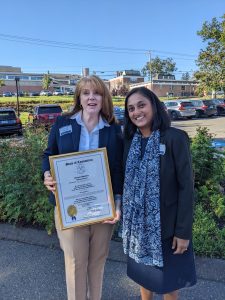written by Judy Maloney, YCC Guide
Why unfilled moments help children grow
In today’s world, children are rarely without stimulation. Between busy schedules, screens, and a constant stream of toys and activities, the moments of stillness that once allowed children to imagine, reflect, and simply be have become rare. Yet in Montessori education, we see those quiet, unstructured moments, those times when a child may even appear “bored”, as powerful opportunities for growth.
Boredom as an Invitation, Not a Problem
When a toddler says, “I’m bored,” it can be tempting to quickly offer a toy, turn on a song, or find something to fill the gap. But in doing so, we may unintentionally take away the child’s chance to engage their imagination and inner motivation.
From a Montessori perspective, boredom is not the absence of activity; it is the beginning of creativity. When a child experiences a lull, their developing mind begins to search: What can I do? What can I create? How can I use what’s around me? This internal searching strengthens concentration, problem-solving, and resilience.
It’s in these unhurried moments that children discover the joy of building a tower with blocks, the fascination of watching how sunlight moves across the floor, or the satisfaction of pouring water back and forth simply to see what happens. The space left by boredom becomes the stage on which imagination and curiosity come to life.
Learning to Wait: A Foundation for Self-Regulation
Alongside the gift of boredom is another equally important skill: learning to wait. Toddlers live deeply in the present moment; waiting for a turn, a snack, or a parent’s attention can feel monumental. Yet, every time a young child waits, whether for help with their shoes or for their turn to feed the class fish, they are developing patience, emotional control, and empathy.
Dr. Maria Montessori observed that children thrive when they are given the opportunity to practice waiting rather than being constantly rushed or immediately satisfied. She wrote about the importance of the child’s “inner work,” the gradual strengthening of will and self-discipline that comes from experience, not instruction.
When we slow down and allow the child to experience waiting, we communicate an important message: You are capable of handling this feeling. You can wait, and I will be here with you while you do. Over time, this becomes the foundation for self-regulation, the ability to manage impulses, delay gratification, and persist through challenge.
Supporting These Skills at Home
You can nurture boredom and waiting in simple, everyday ways:
- Allow pauses. If your child says, “I’m bored,” resist the urge to immediately intervene. Stay calm and curious: “Hmm, I wonder what you’ll decide to do.”
- Model waiting. Let your child see you waiting patiently – at a red light, in a line, or while someone else speaks.
- Create screen-free time. Protect quiet, device-free moments in your child’s day. These are often when the richest independent play emerges.
- Honor slow transitions. Give extra time for dressing, eating, or leaving the house. The process is where learning happens.
- Acknowledge feelings. Waiting is hard! You can empathize (“It’s so hard to wait for your turn”) while still holding the boundary.
Age-Specific Tips for Parents
For Children 15 Months–3 Years (Toddler)
- Offer just a few simple toys at a time—rotate rather than add more.
- Create small “yes” spaces where they can explore freely without constant redirection.
- Narrate waiting in simple language: “First I put on my shoes, then you.”
- Use practical life tasks—wiping spills, carrying laundry, washing vegetables—to fill natural pauses.
For Children 3–6 Years (Primary)
- Encourage independent choices: “You may choose work from your shelf.”
- Keep screens out of the daily routine to protect deep, creative play.
- Introduce simple turn-taking games that require patient waiting.
- In moments of boredom, invite observation: “What sounds do you hear?” “What do you notice outside?”
For Children 6–12 Years (Elementary)
- Provide open-ended materials—art supplies, building tools, notebooks for inventions or stories.
- Talk together about the value of thinking time and daydreaming.
- Let them experience longer-term projects that require persistence and pauses.
- Encourage them to problem-solve: “What could you try next?” rather than giving immediate answers.














 Mary Lou Cobb’s poignant words resonated deeply with all in attendance, as she imparted timeless wisdom to our children about the values of perseverance and effort. The air was filled with the sweet melodies of our students singing the Tree Song—a cherished tradition that encapsulates our Cobb ethos and profound connection to the natural world.
Mary Lou Cobb’s poignant words resonated deeply with all in attendance, as she imparted timeless wisdom to our children about the values of perseverance and effort. The air was filled with the sweet melodies of our students singing the Tree Song—a cherished tradition that encapsulates our Cobb ethos and profound connection to the natural world.

